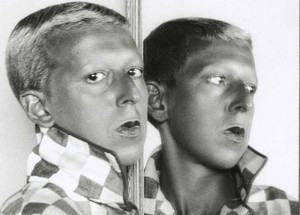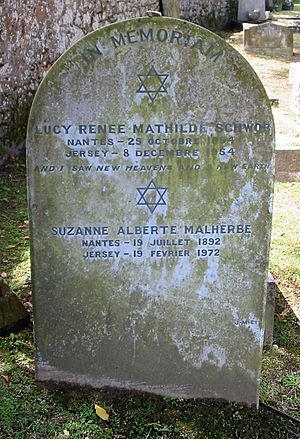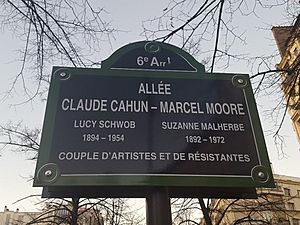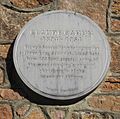Claude Cahun facts for kids
Quick facts for kids
Claude Cahun
|
|
|---|---|
 |
|
| Born |
Lucy Renee Mathilde Schwob
25 October 1894 Nantes, France
|
| Died | 8 December 1954 (aged 60) |
| Resting place | St Brelade's Church |
| Known for | Photography, writing, sculpture, collage |
| Movement | Surrealism |
| Partner(s) | Marcel Moore (1909–1954) |
Claude Cahun (born Lucy Renee Mathilde Schwob; 25 October 1894 – 8 December 1954) was a French artist. She was a photographer, sculptor, and writer. Her work is often linked to Surrealism, an art movement that explored dreams and imagination.
Lucy Schwob started using the name Claude Cahun in 1914. She became famous for her writing and her self-portraits. In these photos, she often dressed up as different characters.
In her writings, Cahun sometimes used the French word "elle" (she) to refer to herself. She also mentioned that she felt her identity was not fixed as only male or female. For example, in her book Disavowals, she wrote: "Masculine? Feminine? It depends on the situation. Neuter is the only gender that always suits me."
During World War II, Claude Cahun also bravely worked to resist the German occupation.
Contents
Early Life and Artistic Beginnings
Claude Cahun was born in Nantes, France, in 1894. She came from a wealthy family interested in literature. Her uncle, Marcel Schwob, was a famous writer. When Cahun was four, her mother became ill and had to live in a hospital. Her grandmother, Mathilde, then raised Cahun.
Cahun went to a private school in England after facing unkindness because she was Jewish at her high school in Nantes. Later, she studied at the University of Paris. She started taking self-portraits when she was about 18 years old in 1912. She continued to take these unique photos of herself for many years.
Around 1914, she chose the name Claude Cahun. Before this, she had used other names like Claude Courlis and Daniel Douglas. In the early 1920s, she moved to Paris with her lifelong partner, Suzanne Malherbe. Suzanne also adopted the name Marcel Moore. They became stepsisters in 1917 when Cahun's father married Moore's mother. Cahun and Moore had already been artistic and personal partners for eight years by then.
For the rest of their lives, Cahun and Moore worked together on many projects. They created written works, sculptures, and photomontages (pictures made by combining different photos). They published articles and novels and became friends with other artists and writers like Henri Michaux and Robert Desnos.
Around 1922, Cahun and Moore started hosting gatherings for artists at their home. Famous artists like André Breton and writers like Sylvia Beach often attended these events.
Exploring Art and Identity
Cahun's art included writing, photography, and theater. Her most famous works are her self-portraits and staged scenes. These often used the visual style of Surrealism, which is about dreams and imagination. In the 1920s, Cahun took many self-portraits where she appeared as different characters. These included an aviator, a doll, a bodybuilder, an angel, and a Japanese puppet.
In some of her portraits, Cahun looks directly at the camera. Her head is shaved, and often only her head and shoulders are shown. She often blurred the lines between male and female appearances. This challenged traditional ideas about gender. Experts say that theater, performance, and costumes were very important to Cahun's work. These elements helped her explore different ways of presenting herself.
Cahun also published writings. "Heroines" (1925) was a series of stories based on female fairy tale characters. She cleverly compared them to women in her own time. Aveux non avenus (1930) was a book of essays and dreams. It included her unique photomontages. She also wrote many essays for magazines.
In 1932, Cahun joined a group for revolutionary writers and artists. There, she met André Breton, a key figure in Surrealism. After this, Cahun became more involved with the surrealist group. She took part in several surrealist art shows in 1936, including exhibitions in London and Paris. One of Cahun's famous photographs from the London exhibition showed Sheila Legge in Trafalgar Square. Sheila's head was hidden by flowers, and pigeons sat on her arms. This photo appeared in many newspapers.
In 1934, Cahun wrote a short essay called Les Paris sont Ouverts. In 1935, she helped start an anti-fascist group called Contre Attaque with André Breton. Breton called Cahun "one of the most curious spirits of our time."
In 1994, an exhibition of Cahun's photographic self-portraits was held in London. It was called Mise en Scene. In these surrealist self-portraits, Cahun showed herself as an androgyne (having both male and female qualities), a nymph, a model, and a soldier.
In 2007, musician David Bowie created an exhibition of Cahun's work in New York. It was part of a festival that also featured other artists.
Working with Marcel Moore
Claude Cahun and Marcel Moore often worked together on art. Many people do not realize how much Moore contributed. It is believed that Moore was often the one taking the pictures during Cahun's photo shoots. She was also an equal partner in creating Cahun's collages.
Most of the photographs linked to Cahun came from her personal collection. They were not originally meant for public display. This suggests that these private photos allowed Cahun to experiment more freely with how she presented herself and how viewers might see her.
World War II Resistance
In 1937, Cahun and Moore moved to Jersey, an island near France. When France fell and the Germans occupied Jersey during World War II, Cahun and Moore became active in the resistance. They were strongly against the war and worked hard to create anti-German flyers.
They made these flyers by translating parts of BBC news reports about the Nazis' actions into German. They then put these pieces together to create rhythmic poems and strong criticisms. They signed many of these messages with the German name "Der Soldat Ohne Namen" (The Soldier With No Name). This was to make German soldiers think there was a secret group among their own troops.
The two women would dress up and go to German military events in Jersey. They cleverly placed their pamphlets in soldiers' pockets, on chairs, and in cigarette boxes for soldiers to find. They also quietly crumpled up and threw flyers into cars and windows.
Once, they hung a banner in a local church that said, "Jesus is great, but Hitler is greater – because Jesus died for people, but people die for Hitler." Like much of their art in Paris, many of their resistance messages used this kind of dark humor. Their resistance efforts were not just political actions but also artistic ones. They used their creative talents to challenge the authority they disliked.
In 1944, Cahun and Moore were arrested and sentenced to death. However, the sentence was never carried out because the island was freed from German occupation in 1945. Sadly, Cahun's health never fully recovered from her time in jail, and she died in 1954. Claude Cahun is buried in St Brelade's Church with her partner Marcel Moore. During her trial, Cahun reportedly told the German judge that they would have to shoot her twice because she was both a resistance fighter and Jewish. This story is said to have made the court laugh and may have been one reason her execution was stopped.
Lasting Impact
Cahun created art for herself and did not seek fame. Her work only started to be recognized about 40 years after her death. Cahun's life was full of actions that went against common ideas. Her public image has since become a way to challenge people's ideas about gender, beauty, and logic.
Her art aimed to make viewers question if photography truly shows reality. Her writings also challenged the gender roles of her time and the social and economic limits of the modern world.
Cahun's involvement with the Surrealist group in Paris brought new ideas and representations to their work. Her photographs, writings, and her life as an artistic and political revolutionary continue to inspire artists today.
Cahun's collected writings were published in 2002 as Claude Cahun – Écrits.
In 2018, a street in Paris was named "Allée Claude Cahun – Marcel Moore." It is located near where Claude and Suzanne lived.
Rupert Thomson's 2018 novel, Never Anyone But You, was based on the lives of Cahun and Moore.
Cahun and Moore's brave actions during World War II are described in Jeffrey H. Jackson's 2020 book, Paper Bullets: Two Artists Who Risked Their Lives to Defy the Nazis.
Google honored Claude Cahun with an animated Doodle on its homepage on October 25, 2021. This was on what would have been her 127th birthday.
Images for kids
See also
 In Spanish: Claude Cahun para niños
In Spanish: Claude Cahun para niños








